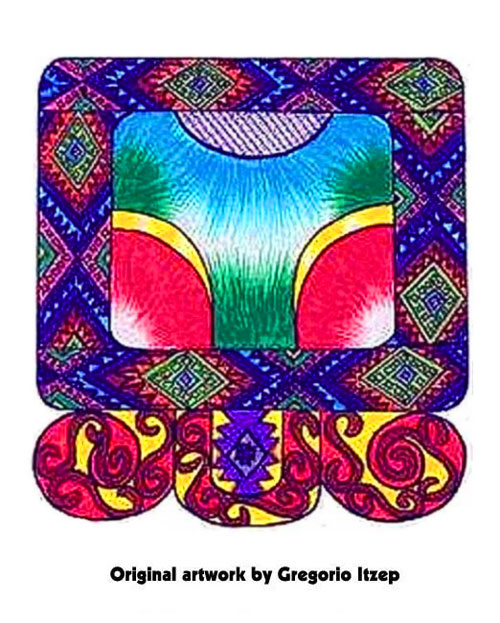
B’atz’ Trecena
by Kenneth Johnson
It is said, in the Popol Vuh that First Mother and First Father gave birth to two sons, One Hunahpu (and Seven Hunahpu. One Hunahpu in turn had two sons, One B’atz’ and One Chouen. The word ‘batz’ means “monkey” and is the K’iche’ name for this day-sign. The word chouen is the same as Yucatec chuen; the literal meaning is “craftsman” or “artisan.” Thus the twins One Monkey and One Craftsman are both manifestations of this day-sign.
One B’atz’ and One Chouen were the primordial artificers and craftsmen. They were flute players, singers, writers, carvers, jewelers, and metalworkers All the fine arts are included in the meaning of this day-sign. The Popol Vuh tells how Hunahpu and his brother journeyed to the Underworld to play handball with the Lords of Darkness. Though they played well, they were tricked and sacrificed by the dark lords. However, the spirit of One Hunahpu impregnated an Underworld girl called Blood Woman. She escaped to the upper world to bear her children, the hero twins Hunahpu and Xbalanque, but the hero twins were mistreated by their half-brothers, One B’atz’ and One Chouen, who were jealous of them and who conspired with First Mother to make sure the younger brothers would receive no food at the family hearth. Instead, Hunahpu and Xbalanque were forced to hunt and provide game for everyone else. In the end, the hero twins got even. They coaxed One B’atz’ and One Chouen into a tree, ostensibly to retrieve some birds killed by the hero twins but stuck in the branches. No sooner had the two artisans ascended than the tree magically began to grow into the sky, leaving One B’atz’ and One Chouen stranded. Then, another magical transformation occurred: they turned into monkeys. They finally succeeded in getting down from the trees and to return to the home of their grandmother, but First Mother just laughed at their ridiculous appearance. They retreated back to the sanctuary of the forest, and remain monkeys to this very day. Despite the fact that they were humbled and turned into animals for their envy of their brothers, they were nevertheless “prayed to by the flautists and singers among the ancient people, and the writers and carvers prayed to them.”
The funerary inscriptions on ancient Mayan ceramics make it clear that the Classic Mayan scribes were painters as well as literary artists and keepers of sacred lore. These members of the Mayan royal houses who specialized in knowledge recognized the Monkey God as their patron deity. Given such an intimate connection between sacred knowledge and creative artistry, we should not be surprised to learn that Monkey is still regarded as the day of the “masters of all the arts” as well as being one of the days dedicated to the Calendar keepers and their lore. Monkey is the day of the craftsman, the wisdom-keeper and the artist. It exemplifies spiritual and creative power.
The K’iche’ word b’atz’ means “howler monkey,” but if you pronounce it as batz, without the glottal stops, it means “thread.” Among the Maya, weaving is one of the most complex and beautiful of the arts. It is the epitome of “women’s wisdom.” The blanket you purchase in the marketplace is a symbolic universe unto itself, for the entire cosmos is said to be like a tangle of threads which must be “unbundled” in order to be woven into a harmonious universe. The world we live in is an orderly pattern, a beautifully woven blanket; but the Underworld below us, Xib’alb’a, is a tangle of chaotic threads, primal and as yet without order. The courses of the planets, of the sun and moon and stars, are a part of that majestically woven pattern. The tangled threads of the Underworld touch our own world in many places, like conduits of energy between one world and the next. These are the places of power, the sacred places alive with magic.
We weave words in the same way that we can weave a blanket. Mayan priests are, by their very nature, prayer-makers, for all ceremony is attended with prayer. To pray is to speak with the greatest eloquence of which we are capable; the Pop Wuj tells us that the Gods created human beings so that we might sing out in praise of the divine force that created us. To weave our prayers with words of supreme eloquence is yet another way of weaving a sense of implicate order into the cosmos.
During this time, we may voice our intent that all we have requested from the universe may be freely given to us. This is an auspicious time for all artistic projects. This day-sign represents “the thread of life,” the weaving of the loom of existence. This is the time to “weave” any matter or project to its perfect completion, as well as to untangle or “unweave” any problem.
http://www.jaguarwisdom.org

